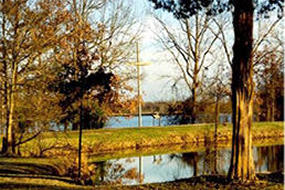Ethnic Heritage: European

Arkansas Post National Monument
In 1686, Henri de Tonti established a trading post known as Poste de Arkansea at the Quapaw village of Osotuoy. It was the first semi-permanent French settlement in the lower Mississippi River Valley. The establishment of the post was the first step in a long struggle between France, Spain, and England over the interior of the North American continent.
The site of that trading post moved seven times during its history due to flooding from the Arkansas River. Because of its strategic location near the confluence of the Arkansas and Mississippi Rivers, Arkansas Post was the location of French, and later Spanish forts. In 1783, the Colbert Incident, the only Revolutionary War skirmish in Arkansas, occurred at Arkansas Post.
In 1800 control transfered again to France and in 1803, Arkansas Post became part of the United States during the Louisiana Purchase. By 1819, the post was a thriving river port and the largest city in the region important enough to be selected the capital of the Arkansas Territory. During the Civil War, Confederate troops tried to maintain tactical control of the confluence of the two rivers, and in 1862 they constructed an earthen fortification known as Fort Hindman. In January, 1863, Union troops destroyed the fort and adjacent river port town, ensuring control of the Arkansas River. Today, the park and museum commemorate the complex history of the site. Located on a peninsula bordered by the Arkansas River and two backwaters, the site offers excellent fishing and wildlife watching opportunities.
- Arkansas Post National Memorial
- Blackstone River Valley National Heritage Corridor*
- Castle Clinton National Monument
- Chesapeake and Ohio Canal National Historical Park
- Christiansted National Historic Site
- Colonial National Historical Park
- Father Marquette National Memorial*
- Fort Caroline National Memorial
- Fort Frederica National Monument
- Fort Necessity National Battlefield
- Fort Raleigh National Historic Site
- Gloria Dei Church National Historic Site*
- Grand Portage National Monument
- Jamestown National Historic Site*
- Jean Lafitte National Historical Park and Preserve
- Keweenaw National Historical Park
- Lowell National Historical Park
- Natchez National Historical Park
- Roger Williams National Memorial
- Saint Croix Island International Historic Site
- Sitka National Historical Park
- Statue of Liberty National Monument
- Timucuan Ecological and Historic Preserve
- Virgin Islands National Park
- Voyageurs National Park